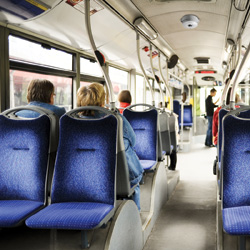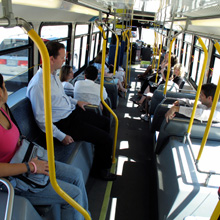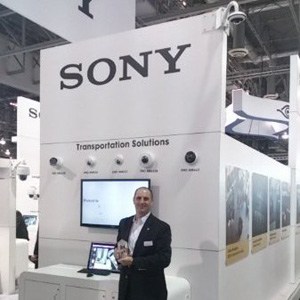 |
| In-vehicle technology allows security officials to view live footage from the bus’ cameras during an emergency |
One of the biggest security opportunities in transportation is onboard surveillance for buses and trains. While most transit organizations have invested heavily in video security for facilities such as terminals and stations, far fewer have taken the next step and installed IP cameras on board vehicles, says John Recesso, strategic business development manager, Sony Electronics’ Security Systems Division.
This is partly due to historic limitations of onboard video surveillance equipment, which has not delivered quality video in poor lighting conditions or on vehicles that are bouncing and shaking, Recesso says. In addition, video has traditionally been recorded to onboard devices that cannot be accessed remotely in real-time, which greatly limits video usefulness in emergency planning scenarios. However, all of that has been changing in the past few years, and onboard surveillance is now more practical and affordable than ever, he adds.
Last year, Sony introduced a series of IP cameras rated for use on board buses and trains, specially designed with ultra-wide-angle lenses that can cover the tight spaces inside a bus or train.
Another major supplier, Panasonic, worked closely with the Denver Regional Transportation District (RTD) Transit Police Division to design and deploy an integrated security solution to replace its aging analog-based system. With Panasonic’s i-PRO Transit Solution in place, Denver RTD has effectively reduced the manpower hours spent manually uploading video data and improved the agency’s ability to better address security issues if and when they occur. The Panasonic solution is currently being installed across Denver’s bus fleet to ensure the safety and security of their bus system for 101 million passenger trips a year.
 |
| Onboard surveillance is now more practical and affordable than ever |
The inside and outside of Denver RTD’s buses were equipped with durable full HD 1080 and HD 720p network cameras. The cameras are integrated with hardware and software components for recording, file transfer, viewing and management to deliver an end-to-end mobile security solution. The in-vehicle technology allows security officials to view live footage from the bus’s cameras during an emergency, from up to a block away.
Panasonic’s open platform compact dome network cameras with microphone capabilities allow communication with the driver and deliver improved video quality along with wider fields of view for onboard applications. The vandal-resistant cameras are engineered to withstand shocks and impacts, and are IP66-rated water and dust resistant. Additionally, the in-vehicle recorders are equipped with anti-vibration mounts to ensure longer-term performance.
In the transportation vertical, March Networks concentrates on providing cameras and video systems on board buses and trains. Products include cameras and hybrid video recorders that are purpose-built for the onboard environment, and a related suite of client and server management software. The company’s end-to-end solutions are geared to operate despite the vibration and other challenges of a moving vehicle. The software is smart enough to do “revision management” – that is, to enable intermittent video downloads whenever connectivity is available and to manage faults, alarms and system health monitoring for a large fleet of assets that are not connected. If something goes wrong, whether a power interruption or camera malfunction, the system has to “understand” the condition and adapt (by delaying startup or shutdown, for example) to ensure that all data is preserved. (In the event that power to the bus is cut, a backup battery keeps the system running until it can be shut down properly.) Also, the system is configurable to specific circumstances. Synchronized mapping metadata (based on global positioning system [GPS] information) can be viewed and searched using a specialized map-based interface.
 |
| March Networks’ Ridesafe GT series of network video recorders are designed to be positioned inside or outside a bus or train |
March Networks’ latest products include the Ridesafe GT series of network video recorders, a variety of mobile cameras with various lenses, HD resolution, using IP or analog, and designed to be positioned inside or outside a bus or train. Transportation is one of three verticals March Networks focuses on – the other two are banking and retail.
One of March Networks’ customers on the West Coast has a fleet of more than 2,000 vehicles, including 40-ft standard buses; 60-ft articulated buses, and shorter “paratransit” buses. The customer’s system includes cameras, NVRs and March Networks’ automation solutions, and also incorporates GPS tracking, WiFi capability and uses an accelerometer to sense a vehicle impact (and provide direction and speed information). Each vehicle has between seven to nine cameras, each operating 18 hours a day, seven days a week. Hundreds of millions of frames of video footage have been collected over the last five years that March Networks has been a supplier. The system streamlines and automates the process of collecting audio, video and metadata from each vehicle in the fleet. The system enables the customer to understand the status of the fleet of buses that are only connected when they visit the depot.
“We have been very successful,” says Rob Schwaber, product manager, mobile/transit products, March Networks. “We have limited their liability, made the video available, saved money in terms of when equipment needs to be replaced.” He says special features in the video management software allow replacement of an element in the system using a configuration template, with automatic provisioning.
Metadata collected by the system includes GPS and accelerometer data, whether a door is open or closed, etc., all synced with the video to simplify investigations. The driver can hit a “panic button” in order to tag a section of video as important, thus ensuring that it will be archived and not purged. (Untagged video is preserved for 30 days.)










































